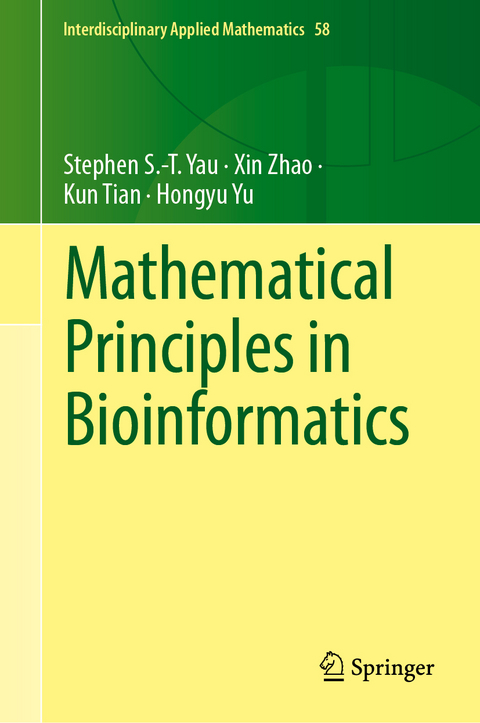
Mathematical Principles in Bioinformatics
Springer International Publishing (Verlag)
9783031482946 (ISBN)
This textbook introduces bioinformatics to students in mathematics with no biology background assumed and it provides solid mathematical tools for biology students along with an understanding of how to implement them in bioinformatics problems. In addition to the basics, the text offers new approaches to understanding biological sequences. The concise presentation distinguishes itself from others on the subject, discussing and providing principles that relate to current open problems in bioinformatics as well as considering a variety of models. The convex hull principle is highlighted, opening a new interdisciplinary research area at the intersection of biology, mathematics, and computer science. Prerequisites include first courses in linear algebra, probability and statistics, and mathematical analysis. Researchers in mathematics, biology, and math-biology, will also find aspects of this text useful.
This textbook is written based on the authors' research works that have been published in various journals along with the lecture notes used when teaching bioinformatics courses at the University of Illinois at Chicago and at Tsinghua University. The content may be divided into two parts. The first part includes three chapters, introducing some basic concepts. Chapter 1 provides biological background in molecular biology for mathematicians. Chapter 2 describes biological databases that are commonly used. Chapter 3 is concerned with alignment methods including global/local alignment, heuristic alignment, and multiple alignment. The second part consisting of five chapters, describes several bioinformatics principles using a rigorous mathematical formulation. Chapter 4 introduces the time-frequency spectral principle and its applications in bioinformatics. In Chapters 5 and 6, two strategies are used, the graphical representation and the natural vector method, to represent biological sequences, and conduct sequence comparison and phylogenetic analysis without alignment. Chapter 7 presents the convex hull principle and shows how it can be used to mathematically determine whether a certain amino acid sequence can be a protein. The last chapter summarizes additional mathematical ideas relating to sequence comparisons, such as new feature vectors and metrics. This part focuses on the governing principle in biology and provides plenty of alignment-free methods, which cannot be found in any other book.
lt;b> Stephen Shing-Toung Yau (Life Fellow, IEEE) received the Ph.D. degree in mathematics from the State University of New York, Stony Brook, NY, USA, in 1976. He was a Member of the Institute of Advanced Study, Princeton, NJ, USA, from 1976 to 1977 and 1981 to 1982. He was a Benjamin Pierce Assistant Professor with Harvard University, Cambridge, MA, USA, from 1977 to 1980. He then joined the Department of Mathematics, Statistics and Computer Science (MSCS), University of Illinois at Chicago (UIC), Chicago, IL, USA, and served for more than 30 years. From 2005 to 2011, he was a Joint Professor with the Department of Electrical and Computer Engineering, MSCS, UIC. After his retirement in 2012, he joined Tsinghua University, Beijing, China, where he is currently a Full Time Professor with the Department of Mathematical Sciences. His research interests include nonlinear filtering, bioinformatics, complex algebraic geometry, Cauchy-Riemann geometry, and singularities theory.,Dr. Yau has been the Managing Editor and Founder of Journal of Algebraic Geometry since 1991 and the Editor-in-Chief and Founder of Communications in Information and Systems since 2000. He was the General Chairman of the 1995 IEEE International Conference on Control and Information. He received the Sloan Fellowship in 1980, the Guggenheim Fellowship in 2000, and the American Mathematical Society Fellow Award in 2013. In 2005, he was entitled the UIC Distinguished Professor.
Xin Zhao received the B.Sc. and M.S. degrees in electronic engineering from the Beijing Institute of Technology, Beijing, China, in 2016 and 2019, respectively, where he is currently pursuing the Ph.D. degree with the School of Electronic and Information. From 2019 to 2021, he was a Research Assistant at the State Key Laboratory of Internet of Things for Smart City, University of Macau, Macau, China. His research interests include signal processing, hybrid beamforming, nonlinear precoding, RIS-aided communication, and convex optimization.
Kun Tian received a bachelor's degree in mathematics and applied mathematics from the Department of Mathematical Sciences, Tsinghua University from August 2008 to July 8. He then later returned to the Department of Mathematical Sciences and went on to receive his Ph. D. degree in Statistics from August 2012 to July 7. In July of 2017, he worked as a Postdoctoral Fellow for Mathematician Chengtong Yau at Tsinghua University. From August 2019 to present, he currently works at the School of Mathematics, Chinese Minmin University as a lecturer.
Hongyu Yu is at the Department of Mathematical Sciences, Tsinghua University, Beijing, People's Republic of China.
Preface.- 1 Biological Overview.- 2 Bioinformatics Databases.- 3 Sequence Alignment.- 4 The Time-Frequency Spectral Analysis and Applications in Bioinformatics.- 5 Graphical Representation of Sequences and Its Application.- 6 The Development and Applications of the Natural Vector Method.- 7 Convex Hull Principle and Distinguishing Proteins from Arbitrary Amino Acid Sequences.- 8 New Features or Metric on Sequence Comparison.- References.
| Erscheinungsdatum | 13.01.2024 |
|---|---|
| Reihe/Serie | Interdisciplinary Applied Mathematics |
| Zusatzinfo | XIII, 167 p. 64 illus., 29 illus. in color. |
| Verlagsort | Cham |
| Sprache | englisch |
| Maße | 155 x 235 mm |
| Gewicht | 435 g |
| Themenwelt | Informatik ► Weitere Themen ► Bioinformatik |
| Mathematik / Informatik ► Mathematik ► Angewandte Mathematik | |
| Naturwissenschaften ► Biologie | |
| Schlagworte | Alignment-free methods • applications bioinformatics • Bioinformatics • bioinformatics text • chaos game representation • convex hull principle • convex-hull principle • Exon prediction • math bioinformatics • math-biology text • natural vector method • phylogenetic analysis • Principles in biology |
| ISBN-13 | 9783031482946 / 9783031482946 |
| Zustand | Neuware |
| Informationen gemäß Produktsicherheitsverordnung (GPSR) | |
| Haben Sie eine Frage zum Produkt? |
aus dem Bereich


